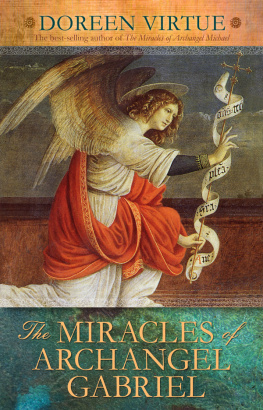
About the Author
Richard Webster (New Zealand) travels around the world lecturing and conducting workshops on psychic subjects. He is the author of over a dozen books, including Palm Reading for Beginners, Feng Shui for Beginners, Spirit Guides & Angel Guardians, and most recently, Candle Magic for Beginners.

Llewellyn Publications
Woodbury, Minnesota
Copyright Information
Gabriel: Communicating with the Archangel for Inspiration & Reconciliation 2005 by Richard Webster.
All rights reserved. No part of this book may be used or reproduced in any matter whatsoever, including Internet usage, without written permission from Llewellyn Publications, except in the form of brief quotations embodied in critical articles and reviews.
As the purchaser of this e-book, you are granted the non-exclusive, non-transferable right to access and read the text of this e-book on screen. The text may not be otherwise reproduced, transmitted, downloaded, or recorded on any other storage device in any form or by any means.
Any unauthorized usage of the text without express written permission of the publisher is a violation of the authors copyright and is illegal and punishable by law.
First e-book edition 2012
E-book ISBN: 9780738716404
Book design by Michael Maupin
Cover illustration 2004, Neal Armstrong / Koralik & Associates
Cover design by Gavin Dayton Duffy
Edited by Connie Hill
Llewellyn Publications is an imprint of Llewellyn Worldwide Ltd.
Llewellyn Publications does not participate in, endorse, or have any authority or responsibility concerning private business arrangements between our authors and the public.
Any Internet references contained in this work are current at publication time, but the publisher cannot guarantee that a specific reference will continue or be maintained. Please refer to the publishers website for links to current author websites.
Llewellyn Publications
Llewellyn Worldwide Ltd.
2143 Wooddale Drive
Woodbury, MN 55125
www.llewellyn.com
Manufactured in the United States of America
For my good friends,
Dusty and Mary Cravens
Contents
: Who Is Gabriel?
: How to Contact Gabriel
: How to Request Assistance
: How to Contact Gabriel Every Day
: Cord Magic
: Gabriel, Perfumes, and Scents
: Gabriel and Water
: Gabriel and Crystals
: Gabriel and the Chakras
: Gabriel and the Tree of Life
: Conclusion
Introduction
A ngels are beings composed of spirit. Their main purpose is to serve and worship God. They also carry out missions from God, and serve humanity in a wide variety of ways, such as revealing divine truths and helping people gain salvation.
Angels are able to change shape, and have appeared to humans in the guise of men, women, and children. In fact, the popular picture of an angel is of a being who is beautiful, young, and wearing flowing robes, a halo, and large wings. This might be an accurate description some of the time, but angels have the ability to appear in any form they wish.
Angels are genderless, but contain the finest qualities of both men and women to enable them to serve God in the best possible way. They are immortal, in the sense that they do not die as we do. However, they are not eternal, as only God is eternal.
The word angel is derived from the Greek word angelos, which means messenger. In 1951 Pope Pius XII de-clared Archangel Gabriel the patron saint of postal workers, which means the supreme messenger looks after the people who deliver messages. Gabriel is the perfect choice for this, as in an old Jewish legend she introduced herself to Abraham by saying, I am the angel Gabriel, the messenger of God. Also, of course, Gabriel brought the most important message of all when she visited the Virgin Mary and told her that she would give birth to Jesus Christ.
Angels have been working as divine messengers for thousands of years. They are considered to be intermediaries between God and mankind in the religious traditions of most faiths, and are still fulfilling that role today. Of course, they also mediated between Jesus and the heavenly Father.
However, angels are much more than beings who simply distribute messages. They constantly attend the throne of God (Genesis 32:1; Psalms 103:21; 1 Kings 22:19; Job 1:6). They possess a strong sense of right and wrong (2 Samuel 14:17). They rejoice every time a sinner repents. However, they will, when necessary, punish the wicked (Genesis 22:11; Exodus 14:19; Numbers 20:16; Psalms 34:7). They also protect the good. They keep company with people when they pray, and carry the souls of the just to heaven. They can change their form when, and if, required. The enduring words: Be not forgetful to entertain strangers: for thereby some have entertained angels unawares (Hebrews 13:2) relate to this. The angels work ceaselessly for God, and will be present at His second coming.
In the Islamic tradition, two angels are assigned to everyone at birth. One records the persons good deeds, while the other writes down the bad ones. Fortunately, the evil deeds are not recorded until after the person has fallen asleep, as this allows him or her some hours in which to repent. If this occurs, the record shows that God has pardoned him or her.
Angels are, of course, also responsible for looking after the good and the innocent. The early Christian fathers taught that every human being is appointed a guardian angel at birth. The angel performs this task, not only as a duty to God, but also from feelings of love for the person he or she is protecting. The guardian angel works for his or her human until the persons soul is carried to heaven. If necessary the guardian angel will visit his charge in purgatory. In The Divine Comedy, Dante describes how souls in purgatory were comforted by their guardian angels. Raphael is considered the prince of guardian angels.
Jesus expressed a belief in angels (Matthew 26:53; John 1:51), and was helped by them in moments of crisis. In Matthew 4:11 angels came and ministered to him after he had been tempted by the devil. At the Mount of Olives, Jesus knelt down and prayed, Saying, Father, if thou be willing, remove this cup from me: nevertheless not my will, but thine, be done. And there appeared an angel unto him from heaven, strengthening him (Luke 22: 4243).
The early Christian church was extremely interested in anything to do with angels, and scholars immediately tried to classify them into groups, or hierarchies. The best known of these was created in the sixth century by Dionysius, the Areopagite, in a book called The Celestial Hierarchies . Most of the later arrangements of angels were based on his work. His sequence is:
1. Seraphim
2. Cherubim
3. Thrones
4. Dominions
5. Virtues
6. Powers
7. Principalities
8. Archangels
9. Angels
In many ways, this list is surprising, as archangels are in the second to last position. They are also placed in this position in the hierarchies created by St. Ambrose, St. Jerome, St. Gregory, and John of Damascus. However, there are archangels on each side of Gods throne, showing their importance. Dionysius arranged his angels deliberately. The higher ones carried out cosmic concerns, while the lower ones looked after matters on the earth.
The Christian Church found angels a difficult subject to deal with. The first Ecumenical Council in 325 ce accepted angels as a reality, and decreed that people should make use of the angelic world to reach heaven. However, less than twenty years later this was rescinded, as the council members thought that any interest in angels took the emphasis away from Christ. In 787 ce the Seventh Ecumenical Synod came to the conclusion that angels can act as liaisons between God and mankind.
Next page


















